“We could not realise one single project”
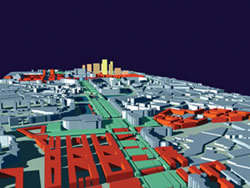 After winning a prestigious award to redesign the urban zone of Bucharest, Prof Meinhard von Gerkan found the lack of interest from Romanian politicians became the greatest frustration he had experienced in 40 years of professional life
After winning a prestigious award to redesign the urban zone of Bucharest, Prof Meinhard von Gerkan found the lack of interest from Romanian politicians became the greatest frustration he had experienced in 40 years of professional life
Bucharest’s southern centre was wrecked through insane developments by Ceausescu in the 1980s.
The dictator levelled a large section of the old city and replaced it with boulevards inspired by North Korea and his elephantine vanity project, the People’s Palace.
Following the revolution, many buildings were left incomplete and vast tracts of land were colonised by rubble, weeds and stray dogs.
To redevelop the area, the Romanian Government held an open competition - Bucharest 2000 - to find a new identity for the city and a new urban plan for the southern centre.
An international jury, which included the architect for New York’s new ground zero project, Daniel Libeskind, chose Prof Meinhard von Gerkan, senior partner in GMP, one of the largest and most prestigious architectural firms in the world.
But what followed was a waste of a talented architectural interest in the Romanian capital.
“We were not able to complete one single project, and we were not compensated, not even once, for costs incurred for flights, or accommodations for any of our activities,” Meinhard von Gerkan tells The Diplomat.
The senior architect, whose group has completed similar projects in Vietnam and China, travelled to Bucharest over 12 times to give speeches and present projects to leading politicians on the city’s development.
“During this time I was forced to realise that only a few committed personalities were interested in pursuing municipal planning and dealing with Ceausescu’s Palace,” von Gerkan says.
The architect helped organise workshops for the updating of Bucharest 2000 for Romanian and German architecture students, eventually presented in the Expo 2000 World Fair in Hanover. Von Gerkan also organised a trip by top experts from Berlin to Bucharest to explain how the Germans grappled with the problems of the restitution and the reunification of Berlin. Many citizens and politicians attended this event, but it produced no results.
“We tried to make contact with political circles and in general to continue to work on the content of the project,” says von Gerkan. “Nothing came of any of these activities.”
Despite the fact that nothing was happening, then President Ion Iliescu still decided to honour von Gerkan with the Romanian National Award in 2002.
“After the 20th invitation to some event or other, where I was supposed to give a paper, I finally said, wait a minute: the expenses I had incurred until then were enough. Nothing happened anyway, and the whole procedure had become an endless blah-blah,” he says.
“Bucharest is the greatest frustration we have had in 40 years of professional life. And from that standpoint, the Bucharest 2000 competition was a flop for me, nothing more than a dog and pony show paid for by the World Bank for the self-profiling of some ambitious Romanian politicians.”
Potential remains
However, the potential is still there. If politicians and investors would be seriously engaged in putting in practice the ideas of Bucharest 2000 or other similar ventures to overhaul the city, von Gerkan says the interests of world renowned architects would be large.
“I myself would be ready to undertake one or more projects in Bucharest as architectonic examples of contemporary architecture, if I had even the slightest sense that there was any interest at all on the part of the Romanian Government and the investors,” says von Gerkan. “My impression is that the sole interest in urban development and architecture [in Bucharest] is to extract the greatest possible profit from the real estate and to market mediocre and, in part, miserable architecture projects.”
No grand designs
 Bucharest is on the radar for international architectural firms, but they have yet to see a concrete proposal that could win their interest.
Bucharest is on the radar for international architectural firms, but they have yet to see a concrete proposal that could win their interest.
One of the only buildings constructed by the largest European architectural firms is the Bucharest Business Park in the north of the city on the Bucharest-Ploiesti highway, designed by Adest Consulting (part of Equator Europe) in association with Alpha Studio and Chapman Taylor.
But hiring an international firm to build a major project in Bucharest could be an excellent way for the city to gain interest from abroad.
In office buildings, Richard Rogers’ Lloyd’s Building in the City of London helped redefine the notion of the private sphere, emphasising transparency as opposed to concealment, in the business environment.
In public architecture, Frank Gehry’s design for the Guggenheim Museum in Bilbao transformed the global view on the Basque port, and Daniel Libeskind’s new project for the Denver Art Gallery hopes to have the same effect on the Colorado city.
But opportunities in Bucharest, either in the public or private sphere, have yet to emerge.
“We have not actively been seeking work in Romania, but we are aware of its potential, and would respond positively if invited to work on an interesting project by a reputable client,” says Peter Wislocki, director of European operations, architect and engineering firm RMJM, architects of the Scottish Parliament building and sky-scrapers in Dubai.
“We simply haven’t as yet noticed a suitable procedure to participate in,” says Julian Weyer, architect and associate partner at celebrated Danish group CF Moller Architects.
This would need to be a project of sufficient ambition and volume to justify the initial move to work in a new country, says Weyer.
“This surely does not mean that none such projects have been launched in Bucharest,” says Weyer, “but rather that we have not had the opportunity to notice and respond to them, and that we at times have chosen not to apply to certain projects due to our already extensive involvement abroad.”
Weyer says he sees ‘no hindrance’ in working in Romania.
“For a city like Bucharest, the creation of new types of urban public space and public venues would be particularly relevant, as well as intelligent and inventive conversions or transformations of existing buildings,” says Weyer. “In this aspect the contribution of international architects could be most valuable in terms of bringing cutting edge new concepts and methods into use within the eclectic mix of its context.”
Not as large as Russia, nor as safe as Poland
Romania is also not on the top of some companies’ list due to its size.
“The construction market – and the architectural profession – is extremely busy at present throughout central and eastern Europe,” says Wislocki. “In comparison with Russia, Romania is a tiny market and in comparison with Poland, the Czech and Slovak Republics, Hungary and the Baltics, it is an immature and risky business environment. Bucharest therefore remains something of a niche market for architects as much as for real estate investors.”
Wislocki says that for RMJM to enter a new market the firm would need to be persuaded that the project is commercially sound, the client is reputable and financially secure, and, above all, that the buildings from their designs would be of high quality.
There are also risks associated with permits for construction of specific projects.
“In any new market we would need to collaborate with local professionals,” says Wislocki.
“Our clients could significantly reduce our risks by selecting the most appropriate firms for us to collaborate with locally.”
Major overhaul
‘The Diplomat - Bucharest’ examines some of the large developments under construction, discussed and proposed for the city of Bucharest Centre
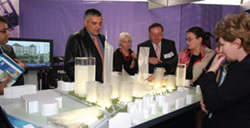 BLVD UNIRII Canadian-Hungarian developers TriGranit, together with the Ministry of Transport and Construction and the City Hall intend to create a public-private-partnership to develop land on Boulevard Unirii. The one billion Euro proposal is, at this stage, a futuristic complex of glass and steel. Ideas for the plot include a 70-floor and 200 metre-high ‘Brancusi Tower’ with an echo of the 20th century sculpture’s trademark abstract style in a post-modern office skyscraper and a ‘Twin Towers’ project inspired by the New York World Trade Center. Work is underway to complete the PUZ (Urban Zoning Plan) this Autumn. This will impact the axis between the Parliament Palace and Piata Alba Iulia – where Mayor Videanu wants to see skyscrapers. As we went to press, TriGranit was holding final negotiations to complete the contract, which will happen after the PUZ is adopted. Mayor Videanu says work should start in March 2007 and end by 2014. The Ministry of Transport, which owns the land, will transfer the property to City Hall, after the contract is signed. But there is some dispute from around 85 former land owners (no one lives on the site) and the City Hall has to compensate them before expropriating the land.
BLVD UNIRII Canadian-Hungarian developers TriGranit, together with the Ministry of Transport and Construction and the City Hall intend to create a public-private-partnership to develop land on Boulevard Unirii. The one billion Euro proposal is, at this stage, a futuristic complex of glass and steel. Ideas for the plot include a 70-floor and 200 metre-high ‘Brancusi Tower’ with an echo of the 20th century sculpture’s trademark abstract style in a post-modern office skyscraper and a ‘Twin Towers’ project inspired by the New York World Trade Center. Work is underway to complete the PUZ (Urban Zoning Plan) this Autumn. This will impact the axis between the Parliament Palace and Piata Alba Iulia – where Mayor Videanu wants to see skyscrapers. As we went to press, TriGranit was holding final negotiations to complete the contract, which will happen after the PUZ is adopted. Mayor Videanu says work should start in March 2007 and end by 2014. The Ministry of Transport, which owns the land, will transfer the property to City Hall, after the contract is signed. But there is some dispute from around 85 former land owners (no one lives on the site) and the City Hall has to compensate them before expropriating the land.
BLVD URANUS City Hall’s big vision is the ‘Izvor’ development, a 2.2 billion Euro plan to refurbish the area around Ceausescu’s former People’s Palace, Palatul Parlamentului - the second largest occupied building in the world, after the Pentagon. There is a huge amount of empty space around the palace, which used to be Romania’s largest stadium, Stadionul Republicii.
The programme wants to create a boulevard of bustling retail, office and cultural activity. The new axis will begin at Piata Victoriei, follow Strada Buzesti and Strada Berzei south, cross the Dambovita River at the Hasdeu bridge and then pass alongside the Palatul Parlamentului before linking up with Strada Uranus. This will be a public-private-partnership.
Bucharest Mayor Adriean Videanu says the tender for the design will be launched “as soon as possible”, but gave no date.
REDEMPTION CATHEDRAL The Church has large plans to build a 200 million Euro cathedral on an 11-hectare area opposite the National Museum of Contemporary Art (MNAC) and the Romanian Parliament, along the proposed Blvd Uranus. But the plan is seeing delays. The design has not been launched because there are land issues. Ceausescu bulldozed hundreds of homes in the 1980s to make way for his gargantuan project. What is now left between the Parliament and the JW Marriott hotel is a wasteland of prime real estate. Many of the previous land and building owners are making claims over the area. There was no news, when we went to press, on when a competition could be launched.
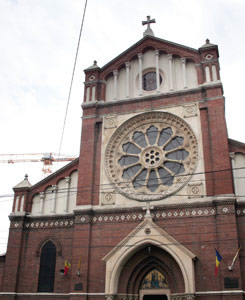 STIRBEI VODA Near the Roman-Catholic Cathedral St Iosif, Millenium Building Development plans to build a 75-metre high office building, dubbed Cathedral Plaza Tower, with four underground levels and 19 above ground. Mayor Videanu says that a 1994 survey suggested a high building in the area, because the Roman-Catholic Cathedral has no high tower. But the proposal has come into conflict with both the Church and the Romanian Intelligence Service (SRI). In 2001 the Roman-Catholic Archdiocese of Bucharest (ARCB) withdrew support for the proposal, due, it alleged, to the fact that another building built in the vicinity, with two underground floors and five levels, had caused damages to ARCB’s buildings. On 24 February 2006, Sector 1 City Hall issued a construction permit allowing Millenium Building Development to go ahead with its plans. Digging works have begun on the building, which has an area of 23,288 square metres and is designed by Westfourth Architecture. But in June this year officials at SRI said, as reported in Jurnalul National, that construction of the office building near the St Iosif Cathedral would seriously harm the functioning of its electromagnetic transmission equipment installed in one of is bases nearby. Where? We do not know.
STIRBEI VODA Near the Roman-Catholic Cathedral St Iosif, Millenium Building Development plans to build a 75-metre high office building, dubbed Cathedral Plaza Tower, with four underground levels and 19 above ground. Mayor Videanu says that a 1994 survey suggested a high building in the area, because the Roman-Catholic Cathedral has no high tower. But the proposal has come into conflict with both the Church and the Romanian Intelligence Service (SRI). In 2001 the Roman-Catholic Archdiocese of Bucharest (ARCB) withdrew support for the proposal, due, it alleged, to the fact that another building built in the vicinity, with two underground floors and five levels, had caused damages to ARCB’s buildings. On 24 February 2006, Sector 1 City Hall issued a construction permit allowing Millenium Building Development to go ahead with its plans. Digging works have begun on the building, which has an area of 23,288 square metres and is designed by Westfourth Architecture. But in June this year officials at SRI said, as reported in Jurnalul National, that construction of the office building near the St Iosif Cathedral would seriously harm the functioning of its electromagnetic transmission equipment installed in one of is bases nearby. Where? We do not know.
North
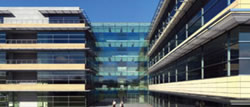 BANEASA One of the largest projects for urban development in Europe, the one billion Euro Baneasa Project, is shifting the city’s development northward. Close to the Baneasa Airport on the DN1 highway to Brasov, the mix of leisure, retail, office and residences is spread across 221 hectares. “Baneasa is being built like a garden,” says Mihail Mateescu, general director of Baneasa Investments. “We use low densities for our buildings and low heights.” The masterplan was drawn by US architects and the buildings in the residential area were designed by Romanians. Already open is cash and carry store Metro and shopping gallery Feeria, which includes Carrefour. Ikea will open next Spring. Next year will see the launch of an exhibition centre for car brands and ‘Baneasa Shopping City’, which will become arguably the largest retail centre in Romania. At the end of 2006 Baneasa Investments will deliver the first 52 sold apartments and, by July 2007, another 85. Also, 100 more apartments on Blvd Agronomiei side are under construction.
BANEASA One of the largest projects for urban development in Europe, the one billion Euro Baneasa Project, is shifting the city’s development northward. Close to the Baneasa Airport on the DN1 highway to Brasov, the mix of leisure, retail, office and residences is spread across 221 hectares. “Baneasa is being built like a garden,” says Mihail Mateescu, general director of Baneasa Investments. “We use low densities for our buildings and low heights.” The masterplan was drawn by US architects and the buildings in the residential area were designed by Romanians. Already open is cash and carry store Metro and shopping gallery Feeria, which includes Carrefour. Ikea will open next Spring. Next year will see the launch of an exhibition centre for car brands and ‘Baneasa Shopping City’, which will become arguably the largest retail centre in Romania. At the end of 2006 Baneasa Investments will deliver the first 52 sold apartments and, by July 2007, another 85. Also, 100 more apartments on Blvd Agronomiei side are under construction.
Northwest
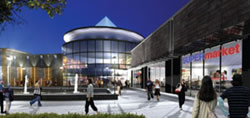 CHITILA The Colosseum centre is a 408 million Euro planned retail and leisure complex in Chitila, backed by UK-based Modus Properties and with local partner Nova Imobiliare. With over 150,000 sqm of gross lettable area on a 600,000 sqm plot, the centre aims to have over 200 shops, a cinema, restaurants, bars, play areas, bowling and 6,000 parking spaces. Manchester-based Modus will build up the local public infrastructure around the development, such as a tram and bus station, 12 km of new highway and tram links to the centre from the existing road network. The company has permission from the local authorities for the scheme and is now undertaking detailed design work on the highways. Construction is due to begin in Spring 2007 on the highway, for which a construction company has not yet been selected. As we went to press, Modus was in advanced discussions with both a major food outlet, DIY outlet and a department store to become tenants in the project.
CHITILA The Colosseum centre is a 408 million Euro planned retail and leisure complex in Chitila, backed by UK-based Modus Properties and with local partner Nova Imobiliare. With over 150,000 sqm of gross lettable area on a 600,000 sqm plot, the centre aims to have over 200 shops, a cinema, restaurants, bars, play areas, bowling and 6,000 parking spaces. Manchester-based Modus will build up the local public infrastructure around the development, such as a tram and bus station, 12 km of new highway and tram links to the centre from the existing road network. The company has permission from the local authorities for the scheme and is now undertaking detailed design work on the highways. Construction is due to begin in Spring 2007 on the highway, for which a construction company has not yet been selected. As we went to press, Modus was in advanced discussions with both a major food outlet, DIY outlet and a department store to become tenants in the project.
West
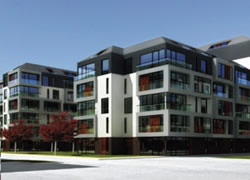 SEMANATOAREA Romanian deve-loper River Invest is building one of the largest integrated projects of urban development in Bucharest, but will need to relocate an existing combine harvester factory, which the developers bought from the state in 1999. The 700 million Euro development will be built on the Semanatoarea factory land and spread over 43 hectares on the banks of the Dambovita River opposite Bucharest’s biggest student campus. ‘Sema Parc’ will include Class A offices, a four-star 18-storey hotel, retail spaces and a residential area of more than 1,200 apartments in four to five-storey buildings. By 2010, more than 50 per cent of the office buildings, the residential project and the retail project will be complete. By 2015 half the office spaces are scheduled for completion. “We have already started preparations in April (demolishing, digging, preparing the land) and building will start soon,” says Larisa Dinu, marketing and communication manager at River Invest. Companies selected to develop the first stage of offices include Austrian Credo Real Estate and, for the retail area, ECE Projectmanagement Romania.
SEMANATOAREA Romanian deve-loper River Invest is building one of the largest integrated projects of urban development in Bucharest, but will need to relocate an existing combine harvester factory, which the developers bought from the state in 1999. The 700 million Euro development will be built on the Semanatoarea factory land and spread over 43 hectares on the banks of the Dambovita River opposite Bucharest’s biggest student campus. ‘Sema Parc’ will include Class A offices, a four-star 18-storey hotel, retail spaces and a residential area of more than 1,200 apartments in four to five-storey buildings. By 2010, more than 50 per cent of the office buildings, the residential project and the retail project will be complete. By 2015 half the office spaces are scheduled for completion. “We have already started preparations in April (demolishing, digging, preparing the land) and building will start soon,” says Larisa Dinu, marketing and communication manager at River Invest. Companies selected to develop the first stage of offices include Austrian Credo Real Estate and, for the retail area, ECE Projectmanagement Romania.
BASARAB The Basarab flyover aims to ease the traffic in the centre of the city with a road from Blvd Nicolae Titulescu, over Calea Grivitei, the railway lines and Blvd Dinicu Golescu, down to Soseaua Orhideelor and Soseaua Grozavesti. The 178 million Euro Bucharest City Hall project should start this Autumn, with Spanish FCC Construccion and Italian-based Astaldi winning the tender to construct the flyover.
South
PARCUL TINERETULUI City Hall is looking to build Bucharest Arena near Sala Polivalenta. This would be a space designed to host exhibitions, cultural and sports events such as sporting World and European championships. With 16,000 seats, this will include courts for indoor sports such as handball, volleyball and gymnastics. There will also be a modern ice-skating rink underneath. This project will go out to tender and Videanu hopes the 45 million Euro project will be finished by September 2008.
East
COMPLEX SPORTIV NATIONAL LIA MANOLIU Bucharest wants to rebuild its national stadium so that it can compete to host the 2009 UEFA Cup Final. “UEFA authorities were in Bucharest and we hope the answer will be positive,” Mayor Videanu says. A ‘circus maximus’ from the Caeusescu era, the stadium is due for a 100 million Euro revamp with money from the Government and City Hall. This will include a restored athletics stadium with up to 15,000 seats and a redeveloped football stadium with a capacity for 52,000. This project aims to start this Autumn and should be finished by the end of 2008.
